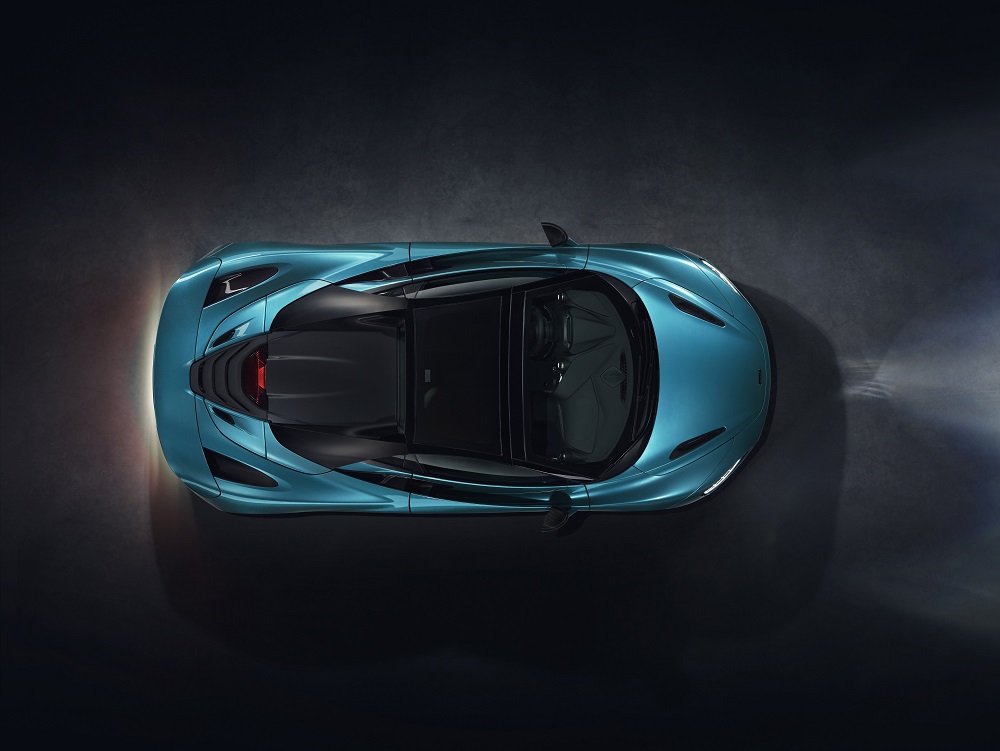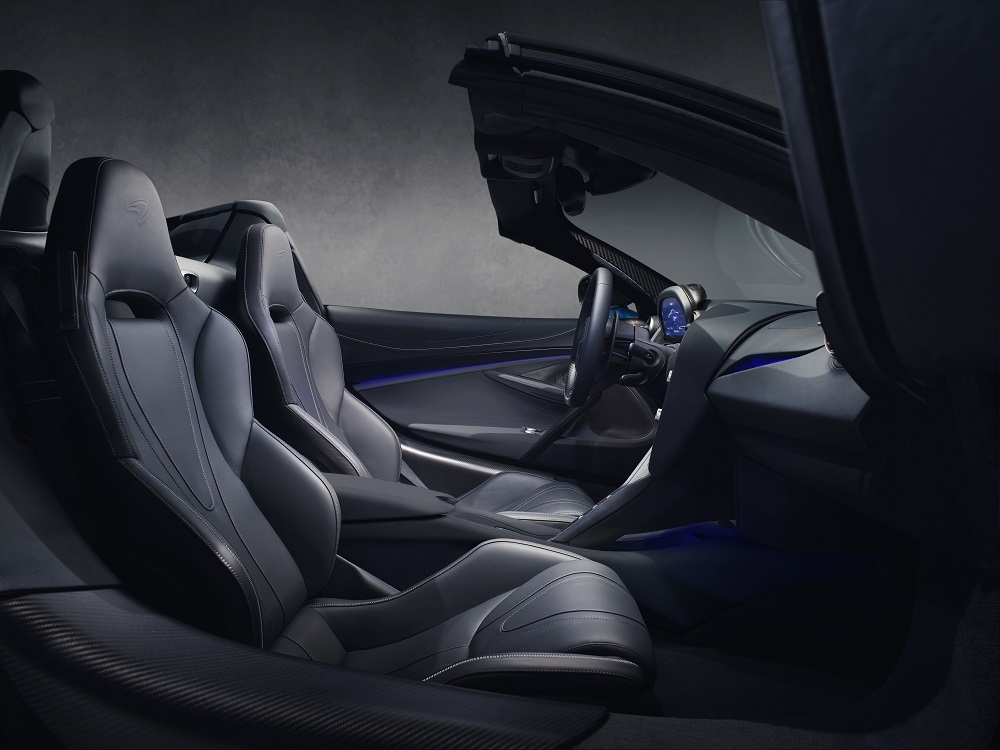New McLaren 720S Spider Lights up the Supercar Class
Unique Glazed Flying Buttresses Aid Rear Visibility
The canopy-like design of the 720S Coupé is recognized for the sense of 360-degree vision it provides, allowing light to flood into the cabin and setting a new benchmark for visibility. This philosophy of unrivalled vision is central to the second-generation Super Series and the new Spider moves the game on again, with unique, glazed flying buttresses further aiding driver visibility as well as adding visual drama to the car.
The leading edge of the buttress features an aerodynamic carrier to guide airflow, before dramatically tapering off to expose darkened glazing; the design and the use of glass delivers a 12% improvement in over-the-shoulder visibility compared to the previous McLaren Super Series Spider.
‘The new McLaren 720S Spider offers an unparalleled blend of extreme performance, crafted luxury, driver involvement and daily usability–all with the additional exhilaration of open-air driving whenever required.’
To accommodate the Retractable Hard Top, the Monocage II-S features a new carbon fiber upper structure engineered to sit as close as possible to the air charge coolers and intake plenum. This maximizes luggage space; there is two cubic feet of stowage available under the tonneau cover with the roof raised. The tonneau cover also sits lower than that of a 650S Spider – again by 0.87in– extending visibility by 24.6ft in length.
The 4.0-liter twin-turbocharged McLaren V8 engine that powers the 720S Spider is unchanged from the Coupé. Mid-mounted for exceptional handling and purity of response, it produces 710bhp and 568 lb ft torque and –given the lightest-in-class weight of the 720S Spider and resulting power-to-weight ratio of 533 bhp-per-ton at lightest dry weight – it is no surprise that performance is extreme.
Acceleration is nothing short of phenomenal, with 0-60mph covered in 2.8 seconds and 0-124mph achieved in just 7.9 seconds – just 0.1 seconds off the pace of the Coupé. The standing quarter mile sprint is dispatched in 10.4 seconds – again, only 0.1 seconds slower than the Coupé – and where conditions allow, the 720S Spider will continue accelerating to a Coupé-matching top speed of 212 mph with the roof raised. Even with the roof lowered, maximum speed remains extraordinary at 202 mph. The minor variations in performance arise from differing aerodynamics and the additional 108 pounds the Spider carries.
The 720S Spider has the same dramatic “eye sockets” cut deep into the front fenders and double-skinned dihedral doors immediately obvious on the Coupé – just two of the body design elements that play an integral role in delivering the extraordinary aerodynamic efficiency and balance the 720S possesses. Beyond this, the front splitter and contoured bonnet, for example, dictate and control the airflow through, over, around and under the rest of the vehicle, while behind the front splitter, the underfloor aerodynamics have been revised to work in harmony with the new rear bodywork and full-width active rear spoiler of the 720S Spider.
The rollover protection technology brings an advantage in respect of size as well as weight, the compact system having allowed McLaren’s design and engineering team to create incredibly slim tonneau buttress. This improves over-the-shoulder visibility for the driver and contributes to a sensation of exceptional space overall, while also increasing aerodynamic downforce.
One-piece Retractable Hard Top is Fastest-operating Supercar Convertible Roof
The Retractable Hard Top (RHT) of the 720S Spider is a completely new design, with a one-piece, carbon fiber roof panel as standard. The hardtop maintains the distinctive silhouette and aerodynamic purity of the 720S Coupé and provides a full carbon fiber upper structure when the roof is closed. The folding mechanism for McLaren’s new RHT is electrically rather than hydraulically driven and the system is the fastest-operating convertible roof in the supercar class, with the retractable hard top lowered or raised in just 11 seconds – six seconds quicker than the 650S Spider. The combination of e-motors and the strength and light weight of the carbon fiber RHT enables a maximum vehicle speed during operation of 31mph – a significant increase from the 18.5mph of the 650S. With these performance statistics, it is no surprise that McLaren has registered three worldwide patents for the roof system.
The new RHT is twice as quiet in operation as the first-generation Super Series convertible, with occupants experiencing additional sound on par with background noise in a quiet library when the roof is operating. This serenity is indicative of exceptional refinement overall, with noise levels inside the cabin of the Spider with the roof raised measurably less than those experienced in a 650S Coupé – true testament to the engineering precision pursued throughout the development of the second-generation Super Series.
A rear window lowers automatically when the RHT is opened, moving to the optimum position to minimize airflow intrusion into the cabin. The window is also independently controllable, allowing occupants to lower it when the roof is closed and invite the sound of the powertrain into the cabin. The fact that the buttresses at their highest point are 1in lower than those of a 650S Spider allows air to flow over the cabin, reducing turbulence to a bare minimum.
‘As the most accomplished convertible supercar ever, the new Spider delivers across a remarkable spectrum of abilities to outstandingly high levels.’
Owners wanting to experience the open-air nature of the 720S Spider even with the roof closed can specify a carbon fiber-framed, glazed RHT option to allow even more light into the cabin if they so choose: the glass is electrochromic and can switch rapidly between a transparent or tinted state at the touch of a button. When the ignition is off, the glass reverts to its tinted setting, helping keep the cabin of the 720S Spider cool during hot days. The electrochromic technology has a memory function that recalls the previous setting selected when the vehicle is next started.
The interior is the same welcoming and luxurious supercar cabin enjoyed by 720S Coupé drivers. Opening a door – which is now a frameless design to accommodate the RHT system – provides access to a truly sophisticated environment, with an extraordinary perception of space and the finest materials in evidence. A new door hinge system and gas strut position was possible without issue because from the outset the 720S program included both Coupé and Spider body styles.
A centrally-mounted 8.0-inch high-resolution Central Infotainment Screen remains the primary hub for the vehicle’s functions. The interface displays audio, media, navigation, climate control and other convenience features, with all the key applications shown on a vertical carousel as well as being available via quick-access ‘hard’ keys below the screen.
The dual-zone climate control and air conditioning system has been recalibrated for the 720S Spider and is able to detect if the RHT position changes from raised to lowered or vice versa. The temperature and airflow is automatically adjusted, warming or cooling occupants according to the ambient settings already selected by increasing airflow into the cabin and moving more air to the footwell or upper cabin areas.




